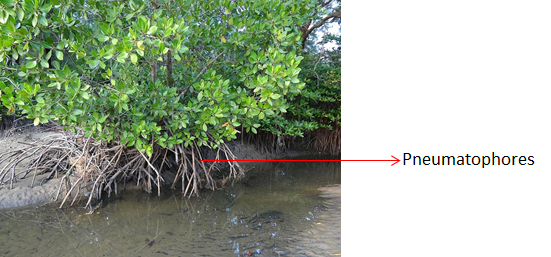
Write a note on pneumatophore.
Answer
474.9k+ views
Hint: Pneumatophores are a type of aerial roots or called apogeotropic roots i.e. against gravity, essentially present in a variety of plants such as Mangroves for facilitating gaseous exchange.
Complete step by step answer:
The roots of some plants growing in saline marshes suffer from the lack of oxygen due to the waterlogged condition of the soil. Saline soil is largely anaerobic making it impossible for the roots to do gaseous exchange through the soil. To cope with this situation, some root branches come out of the ground and grow vertically upwards. These vertically upwards roots are known as pneumatophores. They become aerial roots. These roots bear pneumathodes (lenticels) which are minute openings towards the upper ends through which air enters, passing through the soft spongy tissue to the roots beneath the mud. These roots thus help to get oxygen for respiration. Pneumatophores are characteristics of Mangroves, Rhizophora, etc.

Additional Information:
The main functions of the root system are:
- Absorption of water and minerals from the soil
- Providing anchorage to plant parts
- Storing reserve food material
- Synthesis of plant growth regulators
Roots in some plants change their shape and structure i.e. modify themselves to perform functions other than water conduction. They are modified for support or storage. Example: Prop roots (hanging roots) of the Banyan tree support it. The stems of maize and sugarcane also have stilt roots (supporting roots) coming out of the lower nodes of the stem. Also, the taproot of carrot, turnip, and adventitious roots of sweet potato get swollen to store food.
Note: Pneumatophores are also called respiratory or knee roots. They differentiate the Black mangrove and Grey mangrove from other mangrove species.
Complete step by step answer:
The roots of some plants growing in saline marshes suffer from the lack of oxygen due to the waterlogged condition of the soil. Saline soil is largely anaerobic making it impossible for the roots to do gaseous exchange through the soil. To cope with this situation, some root branches come out of the ground and grow vertically upwards. These vertically upwards roots are known as pneumatophores. They become aerial roots. These roots bear pneumathodes (lenticels) which are minute openings towards the upper ends through which air enters, passing through the soft spongy tissue to the roots beneath the mud. These roots thus help to get oxygen for respiration. Pneumatophores are characteristics of Mangroves, Rhizophora, etc.

Additional Information:
The main functions of the root system are:
- Absorption of water and minerals from the soil
- Providing anchorage to plant parts
- Storing reserve food material
- Synthesis of plant growth regulators
Roots in some plants change their shape and structure i.e. modify themselves to perform functions other than water conduction. They are modified for support or storage. Example: Prop roots (hanging roots) of the Banyan tree support it. The stems of maize and sugarcane also have stilt roots (supporting roots) coming out of the lower nodes of the stem. Also, the taproot of carrot, turnip, and adventitious roots of sweet potato get swollen to store food.
Note: Pneumatophores are also called respiratory or knee roots. They differentiate the Black mangrove and Grey mangrove from other mangrove species.
Recently Updated Pages
Glucose when reduced with HI and red Phosphorus gives class 11 chemistry CBSE

The highest possible oxidation states of Uranium and class 11 chemistry CBSE

Find the value of x if the mode of the following data class 11 maths CBSE

Which of the following can be used in the Friedel Crafts class 11 chemistry CBSE

A sphere of mass 40 kg is attracted by a second sphere class 11 physics CBSE

Statement I Reactivity of aluminium decreases when class 11 chemistry CBSE

Trending doubts
10 examples of friction in our daily life

The correct order of melting point of 14th group elements class 11 chemistry CBSE

Difference Between Prokaryotic Cells and Eukaryotic Cells

One Metric ton is equal to kg A 10000 B 1000 C 100 class 11 physics CBSE

What is the specific heat capacity of ice water and class 11 physics CBSE

State and prove Bernoullis theorem class 11 physics CBSE




